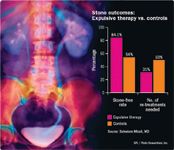Article
Expulsive medical therapy enhances post-ESWL outcomes
San Antonio--Results of a prospective, randomized, controlled study undertaken by Italian urologists indicate that expulsive medical therapy is a useful adjunct to extracorporeal shockwave lithotripsy in the treatment of ureteral stones.
San Antonio-Results of a prospective, randomized, controlled study undertaken by Italian urologists indicate that expulsive medical therapy is a useful adjunct to extracorporeal shockwave lithotripsy in the treatment of ureteral stones.

Fifty patients were randomized to the control group and received ketorolac (Toradol) twice daily for 7 days after the procedure to control pain and inflammation; 63 patients were randomized to receive ketolorac plus expulsive medical therapy for 14 days using the calcium channel blocker nifedipine (Adalat, Procardia), 30 mg/day for patients with upper or middle ureteral stones, and the alpha1-adrenergic antagonist tamsulosin (Flomax), 0.4 mg/day for patients with lower ureteral stones.
The primary endpoint was attainment of a stone-free condition, defined as complete stone clearance or the presence of residual fragments <3 mm. Results from follow-up, which included renal ultrasonography and radiograph of the kidneys, ureters, and bladder performed after 30 and 60 days, showed that patients receiving expulsive medical therapy achieved a significantly higher stone-free rate than controls (84.1% vs. 54%) and at a significantly earlier time following ESWL.

One key aspect of treatment
"This controlled study confirms previous reports regarding the efficacy of expulsive pharmacologic therapies for facilitating ureteral stone expulsion after ESWL. Based on its effectiveness and safety, we believe such therapy is suitable to improve the overall outcomes of ESWL," said Dr. Micali.
"Importantly, however, medication is just one component of our treatment for ureteral stones. The use of a good lithotripter with sufficient force to break the stones is the foundation for achieving good results. We also believe it is important to encourage patients to drink a lot of water to help flush out the fragments," he added.
Dr. Micali's group chose to study nifedipine for upper and middle ureteral stones and tamsulosin for lower ureteral stones on the basis of existing reports describing the use of these drugs for stones in those particular locations. Although corticosteroids also have been used in a combination approach in some other studies, the only other treatment administered in this trial was ketorolac.
The researchers also analyzed stone-free outcomes based on stone location. For each of the three ureteral sites, there were statistically significant differences favoring use of expulsive medical therapy. For patients with upper ureteral stones, the stone-free rate was 77.7% (14/18) in the treated group compared with 47.3% (9/19) for controls. A stone-free rate of 94.1% (16/17) was achieved in patients treated with nifedipine for middle ureteral stones compared with 60% (6/10) for the controls, and 82.1% (23/28) of patients who received tamsulosin for treatment of lower ureteral stones became stone-free compared with only 57.1% (12/21) of controls.





